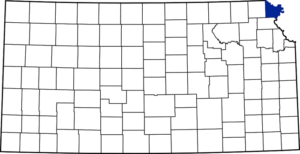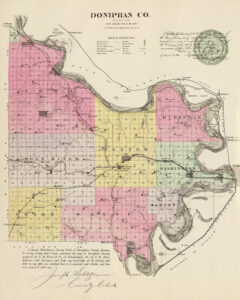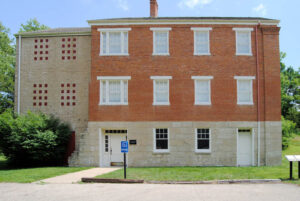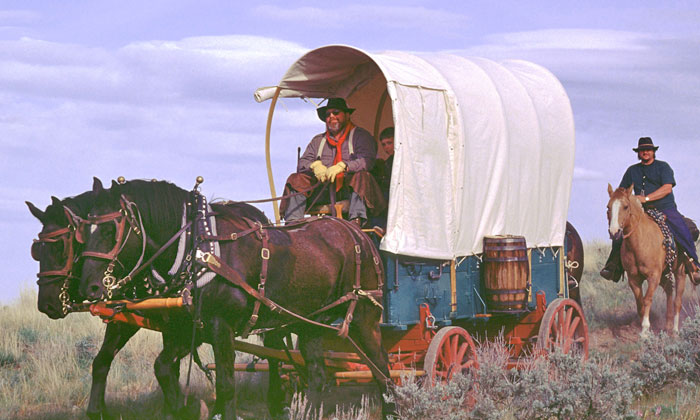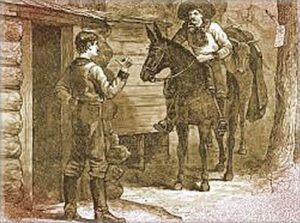Doniphan County, Kansas – Legends of Kansas (original) (raw)
Barns near Highland, Kansas, by Kathy Alexander.
Towns & Places:
Doniphan County, Kansas, location.
Bendena
Denton
Elwood
Highland
Leona – Tiny Town in Doniphan County
Doniphan County, Kansas by L.H. Everts & Co, 1887.
Severance
Troy – County Seat
Wathena
White Cloud – Semi Ghost Town
One-Room, Country, & Historic Schools of Doniphan County
Doniphan County, Kansas, located in the northeastern corner of the state, was one of the 33 original counties formed by the first territorial legislature. Bordered by Nebraska to the north and Missouri to the east, the county has a total area of 398 square miles. It is the third-smallest county in Kansas. Its county seat is Troy, and its most populous city is Wathena.
Though the county is small in area, it is important historically. The Missouri River forms its northern, eastern, and a part of its southern boundary, making 90 miles of riverfront, Atchison County on the south and Brown County on the west form its complete boundaries.
The county’s surface is rolling except for the bluffs along the Missouri River. There are several smaller streams, among which the Wolf River is the most important. It enters from the west, flows in a northeasterly direction through Leona and Severance, and empties into the Missouri River. Clear Creek and Mission Creek also empty into the Missouri River.
The geological formations of Doniphan County are very interesting. Many relics of prehistoric ages have been taken from the bluffs and banks of streams. More than 100 years ago, a large tooth weighing five pounds was unearthed. Mounds in which the prehistoric people were accustomed to burying their dead existed in considerable numbers in the early days of the white man’s occupation. Limestone was found in considerable quantities, sandstone of good quality, and potter’s clay. Coal was also found to some extent, but not in commercial quantities.
Missouri River from the White Cloud, Kansas Overlook by Kathy Alexander.
The white man’s era in Doniphan County began with Etienne Venyard Sieur de Bourgmont, a French explorer and ambassador to the Indians. He and his party arrived and were recorded to have been in contact with the Kanza Indians near Doniphan as early as 1724. They traded goods and established a settlement and friendship before both parties moved on many years later. When Lewis and Clark stopped at the Doniphan site in 1804, they reported that they could tell where the village had been but that no one lived there any longer.
Highland Mission by Kathy Alexander.
By the 1830s, there were four new tribes living in the Doniphan County area, including the Kickapoo, Ioway, Sac, and Fox. The earliest settlement was made in 1837 when the American Board of Foreign Missions sent Reverend S. M. Irvin and his wife as pioneer missionaries. Six months later, Reverend William Hamilton joined them. Reverend S. M. Irvin founded a Presbyterian Mission east of the present city of Highland. The Iowa and Sac mission was established, and the two men wrote and printed several textbooks to be used by the Indians. The first mission school was taught by Reverend William Hamilton, Reverend S. M. Irvin, Miss Walton, and Miss Fullerton. Lumber was brought from Pittsburgh, Pennsylvania, in 1845 to construct a mission building. The old mission still stands near Highland, Kansas.
This mission was the parent church of the first Protestant church in Kansas, the Highland Presbyterian Church. Highland College (now Highland Community College), an outgrowth of the mission school, is the first and oldest higher education establishment in Kansas, chartered in February 1859.
In the late 1840s and early 1850s, thousands of emigrants traveled the St. Joseph, Missouri branch of the Oregon–California Trail. The first emigrant train of any consequence came through the county in 1842. It was led by Peter Burnett and was made up of 25 wagons. One of the earliest emigrants was Mrs. Comstock, who died on the trail near the mission in 1842. This was the first death in the county. In 1850, 25,000 to 30,000 people passed through the Doniphan County area heading for the West Coast.
Oregon Trail Wagon Train Reenactment by the Bureau of Land Management.
With the passage of the Kansas-Nebraska Act of 1854, many settlers moved to the area. “Squatter Sovereignty” was born in Doniphan County in 1854, immediately after the treaty with the Kickapoo Indians. The first “The Squatter Association of Kansas” meeting was held at Whitehead’s Trading Post on June 24. Its purpose was to protect property from claim jumpers. At first, the Squatter’s Association carried out the functions of county government. It served as the place to register claims and as a court to settle disputes over claims. A vigilance committee was formed to guard the rights of settlers and claim owners against losing their property by claim jumpers.
Claim Jumper
Many small towns were established then, including Cincinnati, Buffalo, Landondale, Rogersville, Lee, Smithton, Lawrence II, Fairview, Evansville, Lewiston, Petersburg, Syracuse, Winona, and Iola, none of which exist today. Larger towns at the time included Lafayette, White Cloud, Iowa Point, Charlestown, Columbus, Whitehead’s Trading Post (Bellemont), Roseport (now Elwood), Palermo, Geary City, Doniphan, Troy, Bryan (now Wathena), and Highland.
Doniphan County was surveyed by John Calhoun, who in 1854 was appointed surveyor-general of the twin territories of Kansas and Nebraska. The first officer in the county was James R. Whitehead, who was commissioned constable of the district in 1854 after the state had been districted, and Doniphan, Wolf Creek, and Burr Oak were named voting precincts. Joel P. Blair, Alexander Dunning, and E. V. B. Rodgers were the first commissioners.
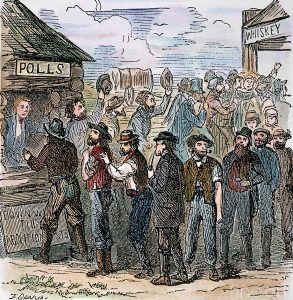
Voting in Kansas.
The county was officially organized in September 1855 and named after General Alexander W. Doniphan, of Mexican-American War fame. He was also an ardent pro-slavery advocate. James Whitehead was elected county clerk, ex-officio probate court clerk, and register of deeds. The commissioners appointed by the legislature to locate a county seat staked off the site of Troy in October of that year. In the state election held in March, the polling places were controlled by armed Missourians. About 15 minutes before the polls opened in the morning, Major Fee, a Free State candidate, announced from the stump that the ticket of his faction would be withdrawn and the pro-slavery men would be allowed a clear field. Notwithstanding this, armed men guarded the polls until they were closed.
Daniel Woodson, who had been acting governor, was the first receiver of the land office at Doniphan and later at Kickapoo, holding this position from 1857 to 1861.
A well-known journalist, Sol Miller, established The Kansas Chief newspaper in White Cloud in 1857. In 1872, he moved the newspaper to Troy. The Kansas Chief is the oldest newspaper in circulation to survive under its original name in Kansas. Miller was also actively involved in politics and the establishment of the Kansas State Historical Society. The Kansas Chief later consolidated with The Wathena Times and The Highland Vidette newspapers. It moved to Wathena, still in weekly circulation today, serving all of Doniphan County.
In December 1859, Abraham Lincoln came to Doniphan County during his campaign trail to speak on antislavery in Elwood, Troy, and Doniphan.
The Pony Express from St. Joseph to the Pacific coast went through Doniphan County in April 1860 and operated for 18 months through Wathena, Troy, Bendena, Denton, and Purcell.
The drought of 1860 caused great suffering in Doniphan County and other parts of the state, and they received relief of 138,750 pounds of provisions.

Missouri Border Ruffians
Doniphan, a border county, suffered considerable annoyance and damage to life and property from the raids of the border ruffians. In 1860, guards were kept on duty at night in all the little cities. The women took an essential part with the men in protecting their homes, and many were instances of courage on the part of young girls and women in times of distress and danger. In one instance, a girl in men’s clothes was shot by a guard.
The Central Overland California & Pikes Peak Express Company also ran through the county, providing 10-day delivery between the terminal points. There were 40 riders in the saddle in each direction, 190 stations, and 400 station keepers that kept the operation working smoothly. The route closely follows the current path of Highway 36 through four more counties west before trailing northwest into Nebraska.
The first railroad in Kansas was built in 1860 between Elwood and Wathena. Shortly after, work on the railroad was discontinued due to the eruption of the Civil War.
After the Civil War and the border troubles were settled, the people began improvements again. Three miles of track had been laid in 1860 near Wathena by the St. Joseph & Grand Island Railway Company. After the close of the war, a new company was organized, and Doniphan County voted for bonds for the construction of the road. Travel up to this time had been carried on by boat on the rivers, stage, and freight wagon west of St. Joseph, Missouri. This first road entered the county at Elwood and passed through Wathena and Troy, leaving about midway on the western line. The next road to be built was the Atchison & Nebraska, for which the county voted 200,000inbondsandgaveindividualsubscriptionsof200,000 in bonds and gave individual subscriptions of 200,000inbondsandgaveindividualsubscriptionsof10,000. This road was built as far as White Cloud in 1871. The St. Joseph & Elwood Bridge was built the same year. In 1872, a railroad was built from Wathena to Doniphan via Palmero. It was later acquired by the St. Joseph & Western Company, and the rails were taken up and used on that line.
With the development of the railroad, inland cities grew, and fruit production spread to nearly every part of the county. Doniphan County was at one time the apple center of Kansas, and fruit was the main agricultural product in the county until around the 1950s. At that time, there was even a bank in Wathena called Fruit Growers State Bank.
Doniphan County Courthouse in Troy, Kansas, by Kathy Alexander.
By the early 20th century, several towns had disappeared from the map. These include Columbus, Charleston, Lafayette, Normanville, Mt. Vernon, Ridge Farm, Syracuse, Walnut Grove, Whitehead, and Wolf River.
The Doniphan County courthouse in Troy, built in 1906, is the fourth to serve the county. The county offices outgrew the temporary first courthouse by 1858; the second building burned down; by 1900, the third courthouse was deemed too small and razed for the present building. The current courthouse is an excellent example of the Romanesque influence on government buildings in Kansas. George P. Washburn, one of the best architects in Kansas, designed it; the construction grant was given to J.H. Wagenknecht of Wathena for $42,000. The courthouse was dedicated on July 4, 1906, before one of the largest crowds gathered in Troy. The Doniphan County Courthouse, located at 120 E. Chestnut St., Troy, KS, was listed on the National Register of Historic Places in 1974.
Chicago, Rock Island & Pacific Railroad Depot in Troy, Kansas by H. Killiam, 1964.
By 1910, Doniphan County had three lines of railroad: the Chicago, Burlington & Quincy Railroad, extending from southeast to northwest, passing through Troy; the St. Joseph & Grand Island entered from St. Joseph to Elwood and crossed directly west; and the Chicago, Rock Island & Pacific entered in the southwest, running northeast to Troy and east to St. Joseph. Several new towns were established along these tracks, including Moray, Ryan’s Station, Severance, and Leona.
The towns and post offices in 1910 were Bendena, Blair, Brenner, Denton, Doniphan, Elwood, Fanning, Gabriel, Geary, Highland, Highland Station, Iowa Point, Leona, Moray, Palmero, Purcell, Severance, Sparks, Troy, Wathena, and White Cloud.
In 1910, the county’s principal products were wheat, corn, oats, and fruits. At that time, it had about 350,000 bearing fruit trees. It had a population of 14,422. That year, there were 68 organized school districts with a school population of 4,553. Highland University, the outgrowth of the early missions of 1837, is the oldest chartered educational institution in the state. There were Roman Catholic and Lutheran schools at Wathena. The first school for white children was established near Highland in 1858. John F. Sparks was the first teacher. The schoolhouse, built of logs, was on the building site now belonging to District 56. In 1867 an unsuccessful attempt was made by the Methodist church to found a boarding school at Burr Oak.
Brick school in Wathena, Kansas, about 1940.
In 1979, the Indian Monument “Tall Oak” was sculpted from a 250-year-old burr oak tree by artist Peter Toth in the courtyard in front of the courthouse. Toth created one monument for each of the fifty states to raise the nation’s awareness of the plight of the American Indians. Tall Oak stands nearly 27 feet tall.
As of the 2020 census, the county population was 7,510.
Today, eight barge lines travel the Missouri River, and a Port Authority is located across the river in Saint Joseph, Missouri. The river provides much of the water for the eastern part of the county.
The county is crossed east to west by U.S. 36 Highway, with agriculture being the primary industry.
© Kathy Alexander/Legends of Kansas, updated August 2024.
Also See:
Kansas Counties
Kansas Destinations
Sources:
Blackmar, Frank W.; Kansas: A Cyclopedia of State History, Vol I; Standard Publishing Company, Chicago, IL 1912
Cutler, William G; History of Kansas; A. T. Andreas, Chicago, IL, 1883.
Doniphan County History
Kansas Memory
Kansas Post Office History
Wikipedia

